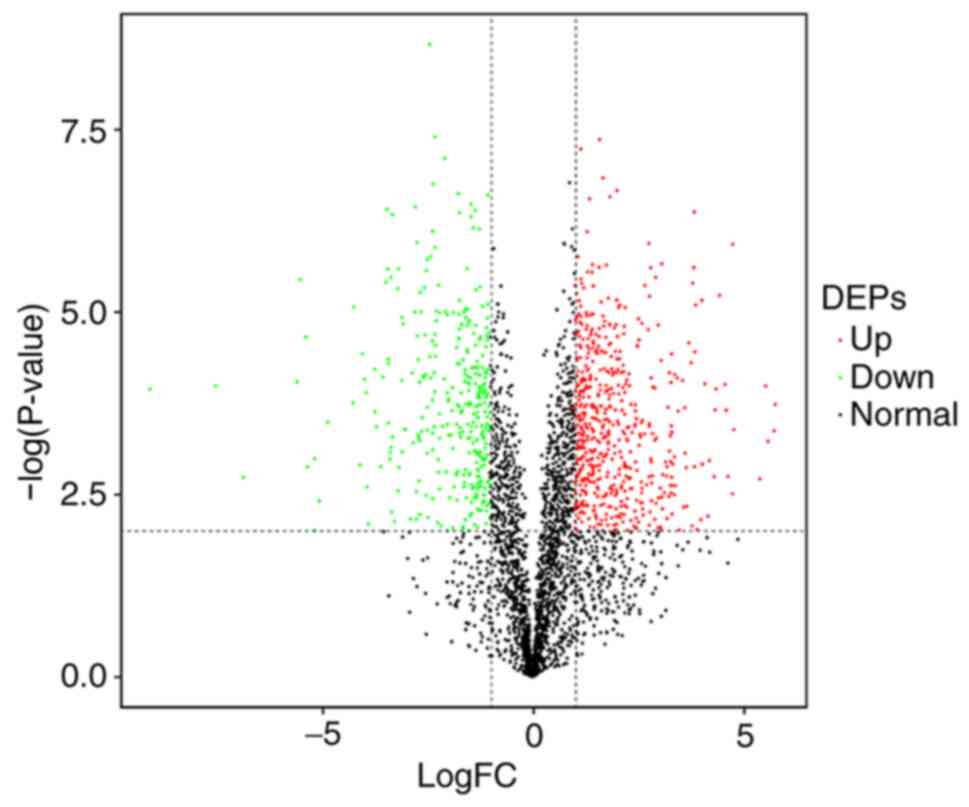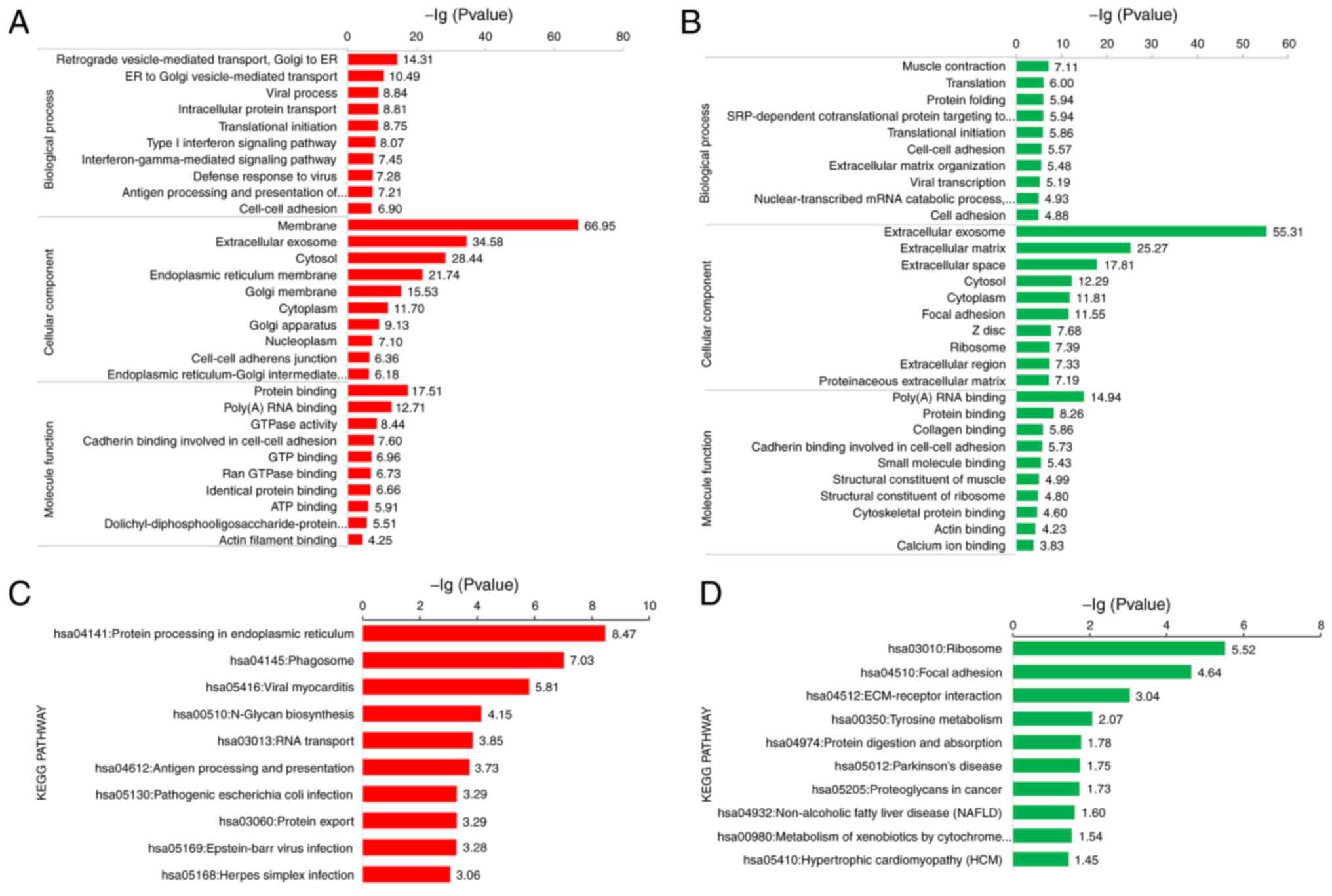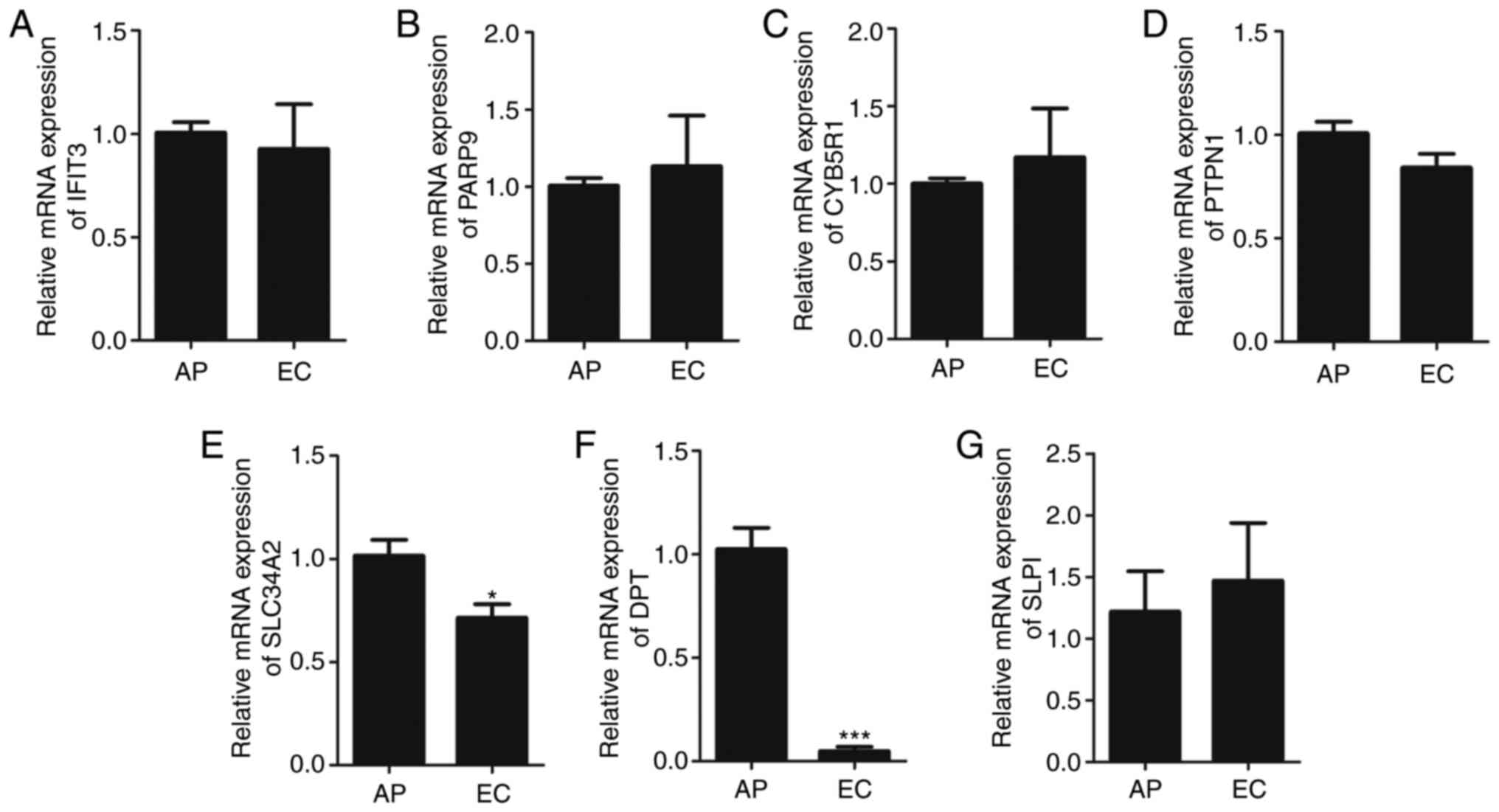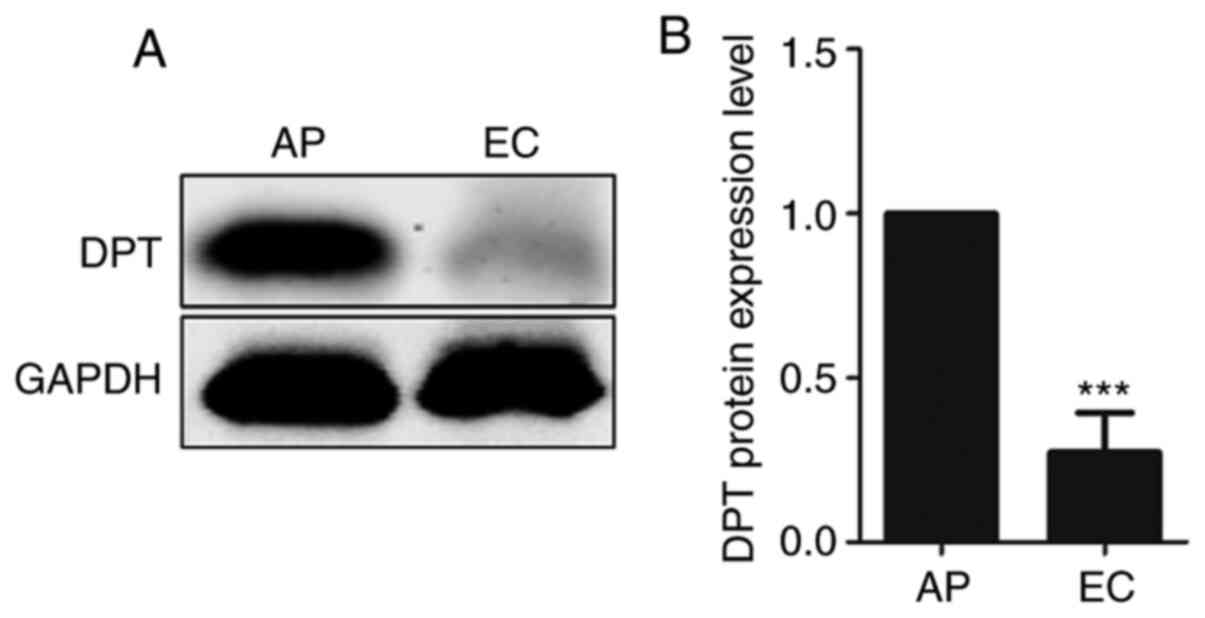|
1
|
Njoku K, Chiasserini D, Whetton AD and
Crosbie EJ: Proteomic biomarkers for the detection of endometrial
cancer. Cancers (Basel). 11:15722019. View Article : Google Scholar
|
|
2
|
Miller KD, Nogueira L, Mariotto AB,
Rowland JH, Yabroff KR, Alfano CM, Jemal A, Kramer JL and Siegel
RL: Cancer treatment and survivorship statistics, 2019. CA Cancer J
Clin. 69:363–385. 2019. View Article : Google Scholar : PubMed/NCBI
|
|
3
|
Martinez-Garcia E, Lopez-Gil C, Campoy I,
Vallve J, Coll E, Cabrera S, Ramon Y, Cajal S, Matias-Guiu X, Van
Oostrum J, Reventos J, et al: Advances in endometrial cancer
protein biomarkers for use in the clinic. Expert Rev Proteomics.
15:81–99. 2018. View Article : Google Scholar : PubMed/NCBI
|
|
4
|
Maxwell GL, Hood BL, Day R, Chandran U,
Kirchner D, Kolli VS, Bateman NW, Allard J, Miller C, Sun M, et al:
Proteomic analysis of stage I endometrial cancer tissue:
Identification of proteins associated with oxidative processes and
inflammation. Gynecol Oncol. 121:586–594. 2011. View Article : Google Scholar : PubMed/NCBI
|
|
5
|
Ueda SM, Kapp DS, Cheung MK, Shin JY,
Osann K, Husain A, Teng NN, Berek JS and Chan JK: Trends in
demographic and clinical characteristics in women diagnosed with
corpus cancer and their potential impact on the increasing number
of deaths. Am J Obstet Gynecol. 198:218.e1–218.e6. 2008. View Article : Google Scholar
|
|
6
|
Giorgianni F, Koirala D and
Beranova-Giorgianni S: Proteomics of the human pituitary tissue:
Bioanalytical methods and applications. Bioanalysis. 6:1989–2003.
2014. View Article : Google Scholar : PubMed/NCBI
|
|
7
|
Peng L, Cantor DI, Huang C, Wang K, Baker
MS and Nice EC: Tissue and plasma proteomics for early stage cancer
detection. Mol Omics. 14:405–423. 2018. View Article : Google Scholar : PubMed/NCBI
|
|
8
|
Neame PJ, Choi HU and Rosenberg LC: The
isolation and primary structure of a 22-kDa extracellular matrix
protein from bovine skin. J Biol Chem. 264:5474–5479. 1989.
View Article : Google Scholar : PubMed/NCBI
|
|
9
|
Okamoto O, Fujiwara S, Abe M and Sato Y:
Dermatopontin interacts with transforming growth factor beta and
enhances its biological activity. Biochem J. 337:537–541. 1999.
View Article : Google Scholar : PubMed/NCBI
|
|
10
|
Okamoto O, Hozumi K, Katagiri F, Takahashi
N, Sumiyoshi H, Matsuo N, Yoshioka H, Nomizu M and Fujiwara S:
Dermatopontin promotes epidermal keratinocyte adhesion via α3β1
integrin and a proteoglycan receptor. Biochemistry. 49:147–155.
2010. View Article : Google Scholar : PubMed/NCBI
|
|
11
|
Krishnaswamy VR, Balaguru UM, Chatterjee S
and Korrapati PS: Dermatopontin augments angiogenesis and modulates
the expression of transforming growth factor beta 1 and integrin
alpha 3 beta 1 in endothelial cells. Eur J Cell Biol. 96:266–275.
2017. View Article : Google Scholar : PubMed/NCBI
|
|
12
|
Mutch D: I231 FIGO Staging of Endometrial
Cancer 2009. Int J Gynaecol Obstet. 107:S58. 2009. View Article : Google Scholar
|
|
13
|
Perez-Riverol Y, Csordas A, Bai J,
Bernal-Llinares M, Hewapathirana S, Kundu DJ, Inuganti A, Griss J,
Mayer G, Eisenacher M, et al: The PRIDE database and related tools
and resources in 2019: Improving support for quantification data.
Nucleic Acids Res. 47:D442–D450. 2019. View Article : Google Scholar : PubMed/NCBI
|
|
14
|
Cox J, Neuhauser N, Michalski A, Scheltema
RA, Olsen JV and Mann M: Andromeda: A peptide search engine
integrated into the MaxQuant environment. J Proteome Res.
10:1794–1805. 2011. View Article : Google Scholar : PubMed/NCBI
|
|
15
|
Alexa A, Rahnenführer J and Lengauer T:
Improved scoring of functional groups from gene expression data by
decorrelating GO graph structure. Bioinformatics. 22:1600–1607.
2006. View Article : Google Scholar : PubMed/NCBI
|
|
16
|
Xie C, Mao X, Huang J, Ding Y, Wu J, Dong
S, Kong L, Gao G, Li CY and Wei L: KOBAS 2.0: A web server for
annotation and identification of enriched pathways and diseases.
Nucleic Acids Res. 39 (Suppl 2):W316–W322. 2011. View Article : Google Scholar : PubMed/NCBI
|
|
17
|
Livak KJ and Schmittgen TD: Analysis of
relative gene expression data using real-time quantitative PCR and
the 2(−ΔΔC(T)) method. Methods. 25:402–408. 2001. View Article : Google Scholar : PubMed/NCBI
|
|
18
|
Takeuchi T, Suzuki M, Kumagai J, Kamijo T,
Sakai M and Kitamura T: Extracellular matrix dermatopontin
modulates prostate cell growth in vivo. J Endocrinol. 190:351–361.
2006. View Article : Google Scholar : PubMed/NCBI
|
|
19
|
Theocharis AD, Skandalis SS, Gialeli C and
Karamanos NK: Extracellular matrix structure. Adv Drug Deliv Rev.
97:4–27. 2016. View Article : Google Scholar : PubMed/NCBI
|
|
20
|
Cavaco ACM, Rezaei M, Caliandro MF, Lima
AM, Stehling M, Dhayat SA, Haier J, Brakebusch C and Eble JA: The
interaction between laminin-332 and α3β1 integrin determines
differentiation and maintenance of CAFs, and supports invasion of
pancreatic duct adenocarcinoma cells. Cancers (Basel). 11:142018.
View Article : Google Scholar
|
|
21
|
Eble JA and Niland S: The extracellular
matrix in tumor progression and metastasis. Clin Exp Metastasis.
36:171–198. 2019. View Article : Google Scholar : PubMed/NCBI
|
|
22
|
Kalluri R: The biology and function of
fibroblasts in cancer. Nat Rev Cancer. 16:582–598. 2016. View Article : Google Scholar : PubMed/NCBI
|
|
23
|
Yamatoji M, Kasamatsu A, Kouzu Y, Koike H,
Sakamoto Y, Ogawara K, Shiiba M, Tanzawa H and Uzawa K:
Dermatopontin: A potential predictor for metastasis of human oral
cancer. Int J Cancer. 130:2903–2911. 2012. View Article : Google Scholar : PubMed/NCBI
|
|
24
|
Fu Y, Feng M-X, Yu J, Ma MZ, Liu XJ, Li J,
Yang XM, Wang YH, Zhang YL, Ao JP, et al: DNA methylation-mediated
silencing of matricellular protein dermatopontin promotes
hepatocellular carcinoma metastasis by α3β1 integrin-Rho GTPase
signaling. Oncotarget. 5:6701–6715. 2014. View Article : Google Scholar : PubMed/NCBI
|
|
25
|
Guo Y, Li H, Guan H, Ke W, Liang W, Xiao H
and Li Y: Dermatopontin inhibits papillary thyroid cancer cell
proliferation through MYC repression. Mol Cell Endocrinol.
480:122–132. 2019. View Article : Google Scholar : PubMed/NCBI
|



















